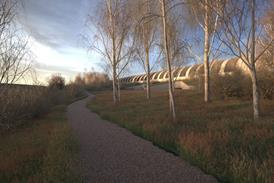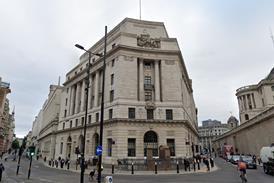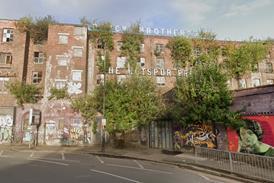- Home
 Full cost of HS2 work around Moxon’s bat tunnel will be £168m, says DfT
Full cost of HS2 work around Moxon’s bat tunnel will be £168m, says DfT Ryder tables plans to transform grade II-listed office on Bank Junction into budget hotel
Ryder tables plans to transform grade II-listed office on Bank Junction into budget hotel Hundreds of signatures for petition to rebuild Manchester’s Hotspur Press after fire
Hundreds of signatures for petition to rebuild Manchester’s Hotspur Press after fire Universal submits planning application for Bedfordshire theme park set to be Europe’s largest
Universal submits planning application for Bedfordshire theme park set to be Europe’s largest
- Intelligence for Architects
- Subscribe
- Jobs
- Events

2025 events calendar Explore now 
Keep up to date
Find out more
- Programmes
- CPD
- More from navigation items
Listing victory jeopardises 700-home Woolwich scheme

Campaigners demand rethink of Panter Hudspith and Glenn Howells proposals as 1930s market wins grade II status
A run-down but pioneering 1930s market building in south London has been awarded grade II-listed status in a move likely to necessitate a major redraw of a 700-home town-centre regeneration scheme.
Government heritage adviser Historic England last week gave Woolwich Public Market crucial national recognition because of its Lamella roof structure – which it said was the earliest of its kind known to survive in the country, and which has a 29-metre span.
Demolishing the market, along with a selection of locally listed Victorian and Edwardian shops and an inter-war neo-Georgian employment exchange, was a key element of regeneration plans for Woolwich, drawn up by Panter Hudspith Architects and Glenn Howells Architects.
…
This content is available to registered users | Already registered?Login here
You are not currently logged in.
To continue reading this story, sign up for free guest access
Existing Subscriber? LOGIN
REGISTER for free access on selected stories and sign up for email alerts. You get:
- Up to the minute architecture news from around the UK
- Breaking, daily and weekly e-newsletters
Subscribe to Building Design and you will benefit from:

- Unlimited news
- Reviews of the latest buildings from all corners of the world
- Technical studies
- Full access to all our online archives
- PLUS you will receive a digital copy of WA100 worth over £45
Subscribe now for unlimited access.


